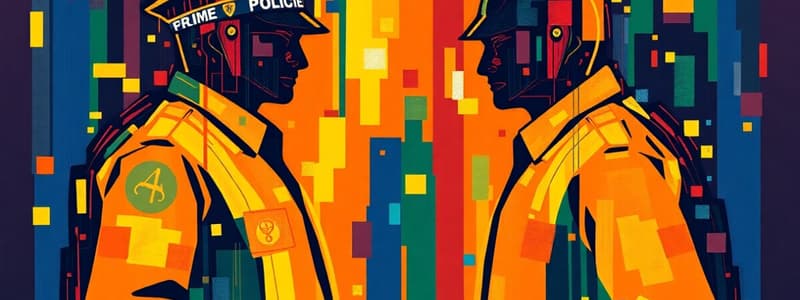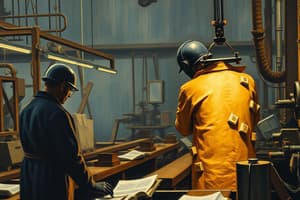Podcast
Questions and Answers
What is the primary objective of administrators in a police department?
What is the primary objective of administrators in a police department?
- Ensuring officers follow law enforcement procedures.
- Overseeing the training and development of police officers.
- Guiding and leading the department by setting an overall direction and responding to the community. (correct)
- Managing the day-to-day tasks of the department.
In the context of community policing, problem-solving is aimed at what?
In the context of community policing, problem-solving is aimed at what?
- Improving police response times to incidents.
- Addressing and eliminating the underlying causes of crime and disorder. (correct)
- Increasing police presence in high-crime areas.
- Managing the volume of calls for service.
What is the role of middle managers in police departments?
What is the role of middle managers in police departments?
- To serve as the interface between administrative policymaking and the actual work in the field. (correct)
- To set the overall direction and strategy for the department.
- To primarily focus on community relations and public outreach.
- To manage only specialized units, such as SWAT teams or detective squads.
What was a key component of professional policing efforts in the early 20th century?
What was a key component of professional policing efforts in the early 20th century?
How does evidence-based policing differ from historical approaches to policing?
How does evidence-based policing differ from historical approaches to policing?
What is the purpose of a police department's mission statement?
What is the purpose of a police department's mission statement?
What does the term "consciously coordinated" imply in the context of a police organization?
What does the term "consciously coordinated" imply in the context of a police organization?
How did the Omnibus Crime Control and Safe Streets Act impact police training and education?
How did the Omnibus Crime Control and Safe Streets Act impact police training and education?
In predictive policing, what is the primary method used to forecast future crime?
In predictive policing, what is the primary method used to forecast future crime?
What is a key distinction between leadership and management in a police organization?
What is a key distinction between leadership and management in a police organization?
Which of the following is the most accurate description of 'order maintenance' as a category of police activity?
Which of the following is the most accurate description of 'order maintenance' as a category of police activity?
What contributed significantly to the rise of intelligence-led policing (ILP)?
What contributed significantly to the rise of intelligence-led policing (ILP)?
What is the purpose of police departments coordinating their activities with adjoining or nearby departments?
What is the purpose of police departments coordinating their activities with adjoining or nearby departments?
According to Sir Robert Peel's principles of policing, what is crucial for maintaining public respect and effectiveness?
According to Sir Robert Peel's principles of policing, what is crucial for maintaining public respect and effectiveness?
What was a primary goal of police-community relations units created in the 1960s?
What was a primary goal of police-community relations units created in the 1960s?
What is considered a police department boundary?
What is considered a police department boundary?
How does intelligence-led policing (ILP) differentiate itself from traditional problem-solving approaches?
How does intelligence-led policing (ILP) differentiate itself from traditional problem-solving approaches?
What is one of the three general categories of activities in a police department?
What is one of the three general categories of activities in a police department?
What factors made leading a police department today more challenging as compared to the past?
What factors made leading a police department today more challenging as compared to the past?
How did police chiefs attempt to exert maximum control over theft officers in the 1950s?
How did police chiefs attempt to exert maximum control over theft officers in the 1950s?
Flashcards
Police Goals
Police Goals
Goals are specific results or achievements toward which police departments direct their efforts.
Law Enforcement
Law Enforcement
Activities where officers investigate crimes and arrest offenders whether for misdemeanors or felonies.
Provision of Services
Provision of Services
Activities where officers are looking for missing children, providing motorist assistance, and engaging in crime prevention activities.
Order maintenance
Order maintenance
Signup and view all the flashcards
Mission statement
Mission statement
Signup and view all the flashcards
Evidence-Based Policing
Evidence-Based Policing
Signup and view all the flashcards
Predictive Policing
Predictive Policing
Signup and view all the flashcards
Community Policing
Community Policing
Signup and view all the flashcards
Intelligence-Led Policing
Intelligence-Led Policing
Signup and view all the flashcards
Community Relations Policing
Community Relations Policing
Signup and view all the flashcards
Citizen Reformers
Citizen Reformers
Signup and view all the flashcards
Bureaucratic Policing
Bureaucratic Policing
Signup and view all the flashcards
Sir Robert Peel
Sir Robert Peel
Signup and view all the flashcards
Maximum Control
Maximum Control
Signup and view all the flashcards
Temper
Temper
Signup and view all the flashcards
Supervisors
Supervisors
Signup and view all the flashcards
Leadership
Leadership
Signup and view all the flashcards
Management
Management
Signup and view all the flashcards
Coordination
Coordination
Signup and view all the flashcards
An Organization
An Organization
Signup and view all the flashcards
Study Notes
Chapter 1 Notes:
- In Richmond, Virginia, predictive policing used to reduce random gunfire, resulting in a substantial increase in random gunfire experienced by the city on New Year’s Eve
- Predictive policing allowed the police in Richmond to anticipate the time, location, and nature of the random incidents.
- The department assigned officers to the locations where gunfire had previously occurred, reducing gunfire by 47 percent and significantly increasing weapons seized.
- The Arlington, Texas Police Department used predictive policing to address a burglary problem
- A direct relationship between burglaries and building code violations was found, and working with other city departments improved neighborhood conditions, which reduced burglaries.
- Predictive policing is still in its early stages of development.
- Predictive policing is expected to become more sophisticated and adopted by more departments
- Police departments have a wealth of data with which to make predictions about crime and disorder
- Goals are the specific results or achievements toward which police departments direct their efforts, and they delineate what needs to be accomplished and guide behavior.
- All activities in a police department should be directed toward the accomplishment of a goal.
- Three general categories of police activities include law enforcement, provision of services to the community and citizens, and maintaining order in the community.
- Law enforcement involves activities where police officers deter crimes, investigate crimes, and arrest offenders for misdemeanors or felonies.
- The provision of services includes activities such as looking for missing children, providing assistance to motorists, and engaging in crime prevention.
- Order maintenance involves officers intervening in fights, family disturbances, protests, and other activities to keep the peace.
- The mix of these activities can vary from one community to another based on their specific needs and problems.
- One way to clarify a department's goals is to examine its mission statement, which is a statement of a department's commitment to the community.
- The LAPD's mission statement includes safeguarding lives and property, reducing crime, enhancing public safety, and improving the quality of life.
- The mission statement establishes broad goals for the department
- Administrators then develop programs and tactics to achieve these goals and reassures the public about what the department is attempting to achieve.
- Intelligent-led policing (ILP) is discussed in chapter 10
- ILP is more proactive because it attempts to identify conditions before they become problems
- Once intelligence information is collected, it must be analyzed and collated into a useable product.
- Evidence-based policing is how administrators make decisions about practices and strategies based on facts
- Evidence-based policing provides a framework for identifying the strategies and tactics to deploy once a problem has been identified.
- Police departments often tailor their responses to a problem, but the tactic used to confront the problem should be based on what works
- There are numerous possible responses to any problem.
- Officers should constantly monitor the situation to determine if the response or strategy produces the desired results.
- Predictive policing is a process where mathematical models or algorithms combine geospatial information to predict future crimes.
- According to the National Institute of Justice it's use is taking data from disparate sources, analyzing it, and then using these results to anticipate, prevent and respond more effectively to future crimes.
- Police departments are now using tools to predict crime, much like Walmart or other big businesses do to predict customer interests.
- The 1960s was a period of great unrest in the country and spawned riots in cities such as Los Angeles, Detroit, and Washington, D.C.
- Police departments across the nation were initially not prepared to handle the disturbances, creating police-community relations units to deal with the disorder.
- As a result of the national disorder problem in 1968, Congress passed the Omnibus Crime Control and Safe Streets Act that was recognition that the police needed assistance.
- The Act also funded police officers' higher education, resulting in the establishment of training programs across the nation.
- Community policing consists of the police working to improve community relationships andPhilosophically, police must work with the community to prevent and solve crimes and to alleviate conditions causing crime and disorder.
- If the police crackdown on the nightclub, a number of fights and assaults will be avoided in the future and problem solving is where causes or instigators of crime and disorder are addressed and eliminated
- Intelligence-led policing (ILP) became prevalent as a result of the 9/11 attacks on New York and Northern Virginia.
- ILP focuses on risk management and involves police officers collecting intelligence about places, people, and activities in an attempt to identify possible or impending problems.
- Citizen reformers were often propelled by police scandals.
- Reform police chiefs used a variety of methods to wrestle control from corrupt politicians.
- By the 1950s, policing was bureaucratic.
- After decades of corruption, chiefs were committed to eliminating graft and corruption.
- Chief officers attempted to exert maximum control over officers thru close supervision.
- Sergeants were assigned to guide officers and ensure they performed their duties.
- Also, chiefs attempted to isolate officers from the public.
- Henry Fielding was appointed as a Bow Street magistrate in London.
- Fielding made 2 pivotal contributions to policing by bringing criminals to justice and writing about crime and poverty.
- Sir Robert Peel was England's home secretary and introduced the Act for Improving the Police in and near the Metropolis in 1829.
- Initially, 1,000 officers were hired and organized into divisions, and the police department was organized around 12 principles.
- Policemen should be hired on a probationary basis.
- Military principles were applied to best organize the police.
- Early American Cities like New York, Boston, and Philadelphia established ineffective watchman systems.
- New York an Boston created a police force in 1854.
- Pennsylvania, Massachusetts and Texas were the first to create state police organizations.
- These departments were inefficient and rife with corruption under the control of local politicians.
- The first policing system to evolve was the frankpledge system
- England became heavily populated with thousands of people and the people of London responded by creating early night watches.
- A robbery unit commander will examine accidents and direct traffic officers to reduce the number of crashes.
- Middle managers are the interface between administrative policy making and the actual work.
- Supervisors, manage subordinates by monitoring activities.
- Supervisors are able to identify a number of problems and take corrective action.
- Supervisors back up their officers on calls or investigations.
- Leadership and management are key ingredients in a police department for every officer.
- Administrators must ensure that personnel have these important skills.
- Leadership and management are also responsible for the harmonious coordination in the police department.
- Supervisors are concerned with tasks and human resources and also attempt to solve problems and difficulties thru training.
- Managers generally are responsible for units within a police department.
- Administrators guide and lead the department by setting an overall direction
- Leadership is getting things done through other people while management consists of putting leadership into action.
- Tools involved include decision making, planning, providing direction, communication, and budgeting.
- Police chiefs need to communicate to find out how citizens and the community respond.
- An organization may be formally defined as "a consciously coordinated social entity with a relative identifiable boundary, that functions to achieve a common goal."
- Social entity refers to an organization being composed of people that interact with citizens.
- A relatively identifiable boundary alludes to the organization's goals and the public served.
- Policing environment is always changing.
- Leadership has the firm understanding of how the environment is operationalized.
- The first concept of organizations is that most of them are small. The New York City Police Department has more than 30,000 officers while most organizations have 10 or less.
Studying That Suits You
Use AI to generate personalized quizzes and flashcards to suit your learning preferences.




